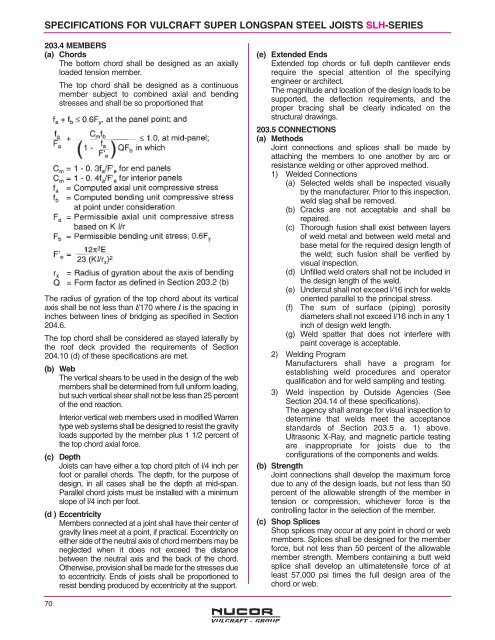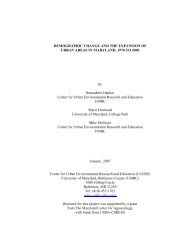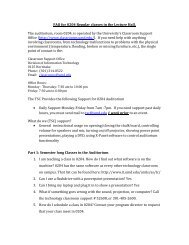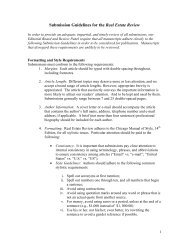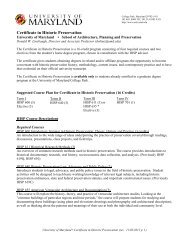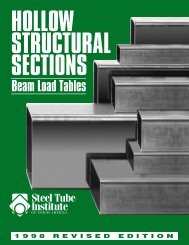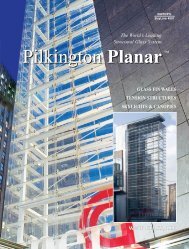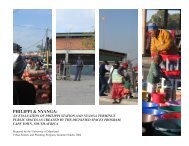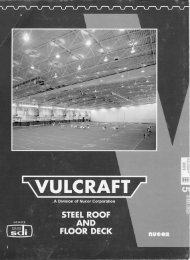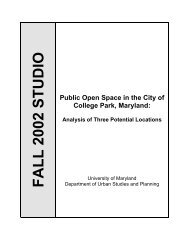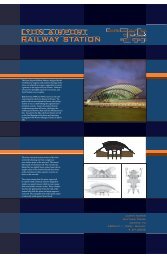Vulcraft_Joist_Catal..
Vulcraft_Joist_Catal..
Vulcraft_Joist_Catal..
- No tags were found...
Create successful ePaper yourself
Turn your PDF publications into a flip-book with our unique Google optimized e-Paper software.
SPECIFICATIONS FOR VULCRAFT SUPER LONGSPAN STEEL JOISTS SLH-SERIES<br />
203.4 MEMBERS<br />
(a) Chords<br />
The bottom chord shall be designed as an axially<br />
loaded tension member.<br />
The top chord shall be designed as a continuous<br />
member subject to combined axial and bending<br />
stresses and shall be so proportioned that<br />
The radius of gyration of the top chord about its vertical<br />
axis shall be not less than l/170 where l is the spacing in<br />
inches between lines of bridging as specified in Section<br />
204.6.<br />
The top chord shall be considered as stayed laterally by<br />
the roof deck provided the requirements of Section<br />
204.10 (d) of these specifications are met.<br />
(b) Web<br />
The vertical shears to be used in the design of the web<br />
members shall be determined from full uniform loading,<br />
but such vertical shear shall not be less than 25 percent<br />
of the end reaction.<br />
Interior vertical web members used in modified Warren<br />
type web systems shall be designed to resist the gravity<br />
loads supported by the member plus 1 1/2 percent of<br />
the top chord axial force.<br />
(c) Depth<br />
<strong>Joist</strong>s can have either a top chord pitch of l/4 inch per<br />
foot or parallel chords. The depth, for the purpose of<br />
design, in all cases shall be the depth at mid-span.<br />
Parallel chord joists must be installed with a minimum<br />
slope of l/4 inch per foot.<br />
(d ) Eccentricity<br />
Members connected at a joint shall have their center of<br />
gravity lines meet at a point, if practical. Eccentricity on<br />
either side of the neutral axis of chord members may be<br />
neglected when it does not exceed the distance<br />
between the neutral axis and the back of the chord.<br />
Otherwise, provision shall be made for the stresses due<br />
to eccentricity. Ends of joists shall be proportioned to<br />
resist bending produced by eccentricity at the support.<br />
(e) Extended Ends<br />
Extended top chords or full depth cantilever ends<br />
require the special attention of the specifying<br />
engineer or architect.<br />
The magnitude and location of the design loads to be<br />
supported, the deflection requirements, and the<br />
proper bracing shall be clearly indicated on the<br />
structural drawings.<br />
203.5 CONNECTIONS<br />
(a) Methods<br />
Joint connections and splices shall be made by<br />
attaching the members to one another by arc or<br />
resistance welding or other approved method.<br />
1) Welded Connections<br />
(a) Selected welds shall be inspected visually<br />
by the manufacturer. Prior to this inspection,<br />
weld slag shall be removed.<br />
(b) Cracks are not acceptable and shall be<br />
repaired.<br />
(c) Thorough fusion shall exist between layers<br />
of weld metal and between weld metal and<br />
base metal for the required design length of<br />
the weld; such fusion shall be verified by<br />
visual inspection.<br />
(d) Unfilled weld craters shall not be included in<br />
the design length of the weld.<br />
(e) Undercut shall not exceed l/16 inch for welds<br />
(f)<br />
oriented parallel to the principal stress.<br />
The sum of surface (piping) porosity<br />
diameters shall not exceed l/16 inch in any 1<br />
inch of design weld length.<br />
(g) Weld spatter that does not interfere with<br />
paint coverage is acceptable.<br />
2) Welding Program<br />
Manufacturers shall have a program for<br />
establishing weld procedures and operator<br />
qualification and for weld sampling and testing.<br />
3) Weld inspection by Outside Agencies (See<br />
Section 204.14 of these specifications).<br />
The agency shall arrange for visual inspection to<br />
determine that welds meet the acceptance<br />
standards of Section 203.5 a. 1) above.<br />
Ultrasonic X-Ray, and magnetic particle testing<br />
are inappropriate for joists due to the<br />
configurations of the components and welds.<br />
(b) Strength<br />
Joint connections shall develop the maximum force<br />
due to any of the design loads, but not less than 50<br />
percent of the allowable strength of the member in<br />
tension or compression, whichever force is the<br />
controlling factor in the selection of the member.<br />
(c) Shop Splices<br />
Shop splices may occur at any point in chord or web<br />
members. Splices shall be designed for the member<br />
force, but not less than 50 percent of the allowable<br />
member strength. Members containing a butt weld<br />
splice shall develop an ultimatetensile force of at<br />
least 57,000 psi times the full design area of the<br />
chord or web.<br />
70


